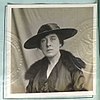English: Anne Murray Dike
Chair of the American Committee for Devastated France from 1917
Recipient of the Croix de Guerre and member of the Legion of Honor
She was born Anne Veitch Murray in Edinburgh Scotland about June 8, 1878.
Immigrated to the US about 1908 in which year she married Francis Harold Dike, a Columbia graduate and instructor in French and English at MIT (1900-10) whom she divorced in 1914.
Was a close friend of Anne Morgan, daughter of J. P. Morgan, who founded the American Committee for Devastated France.
Anne Dike died on February 8, 1929 at the home she shared with Miss Morgan at 43 Rue de Courcelles in Paris of complications of neoplastic myeloma.
New York Times, Feb 20, 1929
“PARIS, Feb. 19.—France paid an unusual tribute to an American woman of Scottish birth today when the Council of Ministers decided "to cite to the nation" in the Journal Officiel Mrs. Anne Murray Dike, president of the American Committee for Devastated France, who died in France on Feb. 8. Through her instrumentality more than 100 villages in Northern France were rebuilt from the ruins in which the war left them. Mrs. Dike was buried last week in one of the little villages she helped to restore.
After recalling that she was decorated with the Croix de Guerre and was an Officer of the Legion of Honor the citation reads:
‘During the war, for fifteen months, frequently under fire, she helped the civil population and the armies in one of the most hotly contested sectors. On two occasions when the Allied troops were falling back she arranged for the evacuation of the women and children, providing the necessary food, clothing, furniture and other material and helping to open dispensaries, milk shops, stores, children’s colonies and travelling canteens and to operate ambulances maintaining meanwhile the morale of all who came in contact with her by her courage.
‘After the armistice, for six years she presided over the restoration of territory 175,000 acres in extent, including two towns and 120 villages, organizing agricultural syndicates, by which the extent of the ruined zone was reduced by one-half. She conceived and brought into being the complete framework of social life – medical consultations, dispensaries, milk rations, hospitals, cantonal hygienic service, social meeting places, courses of instruction, sports grounds, camps for boy scouts, libraries and the Franco-American historical museum school for nurses and librarians. She guaranteed permanence to these institutions by entrusting their future to local committees, which today are continuing her noble work.
‘She gave to France her thoughts her heart and her strength, and high place is due her in the memory of this nation.”



